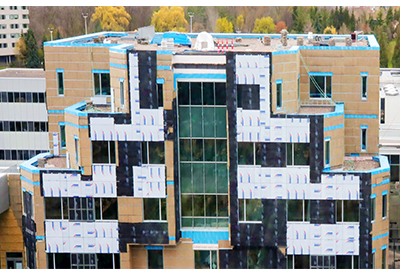Humber Achieves First Zero Carbon Certification in Canada for a Retrofit

July 10, 2019
Humber College’s retrofitted NX building has been awarded the Zero Carbon Building – Design Certification by the Canada Green Building Council, making it the first retrofit in Canada to achieve design certification. A zero-carbon building is highly energy-efficient and offsets the annual carbon emissions using clean renewable energy. Humber’s NX building will use 70 per cent less energy than before, making it the College’s most energy efficient building, and one of the most energy efficient in North America.
“Globally, buildings are responsible for 40 per cent of annual energy consumption and up to 30 per cent of all energy-related greenhouse gas emissions,” said Spencer Wood, Humber’s Director of Facilities Management. “One of the biggest challenges to reducing greenhouse gas emissions in Canada is finding ways to heat buildings at a reasonable cost without burning fossil fuels. Humber wanted to be an example to the Canadian design and construction industries on how a deep energy retrofit can contribute positively to our country’s climate.”
Work on the NX building includes a complete envelope retrofit that is highly insulated and airtight, including new triple-pane windows. Energy efficient upgrades to the lighting, heating and cooling systems and a new 25kW Solar PV system were also completed.
“Congratulations to Humber College for earning a Zero Carbon Building – Design certification for their NX building,” said Thomas Mueller, President and CEO of the Canada Green Building Council. “As the first retrofit to achieve zero carbon design certification, Humber College is showing real leadership and innovation in green building and carbon reduction. The NX building demonstrates that Canada has the expertise and technology now for buildings to reach zero carbon and contribute to global climate change efforts in a meaningful way.”
“We’re immensely proud to be a strategic partner to Humber College in advancing its sustainability leadership within the postsecondary sector in Canada,” said Holly Jordan, Principal, B+H. “The Nx Building exemplifies how, through careful integration across architectural design, energy modelling, envelope design, and mechanical and electrical design, guided by Humber’s unwavering Integrated Energy Master Plan vision, we can look to Canada’s postsecondary institutions as powerful catalysts for change that will continue to drive the green building industry forward.”
Renovations to the NX building, which were designed by B+H architects and constructed by BIRD Construction, began in May 2018 and are scheduled for completion this summer. Originally built in 1989, the North Campus building is 48,269 sq. ft. and five-storeys tall.
To read Canada Green Building Council’s case study on Humber’s NX Building visit here.









![Guide to the Canadian Electrical Code, Part 1[i] – A Road Map: Section 52 — Diagnostic imaging installations](https://electricalindustry.ca/wp-content/uploads/2022/11/Guide-CE-Code-2.png)






